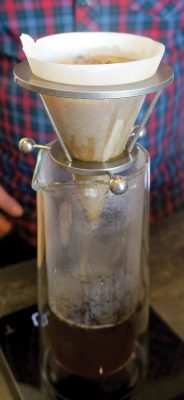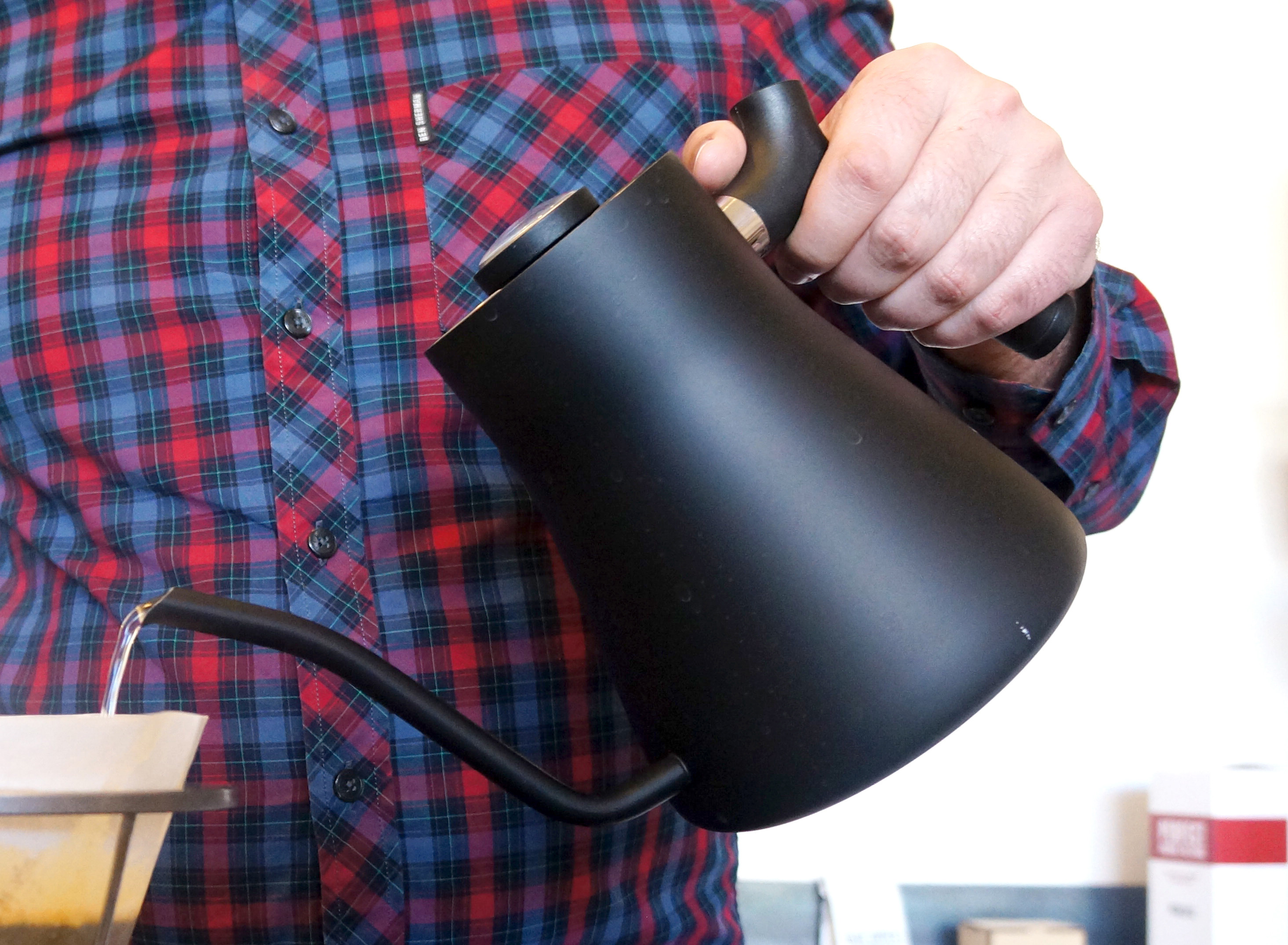The Geometry of Pheonix & Stagg: Pour-Over Coffee with St. Anthony Industries & Fellow Products
Art
Being a Utahn, I’m infatuated with the drinks cultures of beer, spirits and coffee. I’ll take any opportunity to optimize my beverage-drinking experience, whether it’s with glassware, local bitters or, in this case, a pour-over device. If you’ve never experienced a pour-over, it’s a manual coffee-brewing method wherein a barista (at a coffeeshop or at home) pours hot water onto grounds in a filter, which is cradled by a cone-like object that funnels liquid coffee into a decanter. Enter the Phoenix70 by St. Anthony Industries. The company is based in downtown Salt Lake City under the expertise of Khristian Bombeck—the mastermind behind the Alpha Dominche coffee brewer and the head of St. Anthony Industries—his brothers Gregory and Ike Bombeck and Lucas Watts. St. Anthony Industries specializes in design-smart coffee accoutrements for scientifically enhanced coffee enjoyment.
 I’ve long fantasized about making my own pour-overs at home, and St. Anthony Industries piqued my interest as a localized option to make this foray. Watts outfitted me with the Phoenix70, a box of Perfect Paper Filters and a Filibuster Decanter, all of which St. Anthony designs and sells. Without going back to ninth-grade honors geometry, the Phoenix70 (and sister Phoenix70 – V2) is named after a 70-degree angle in its architecture, versus a 60-degree angle in other pour-over apparatuses. This creates 3 inches of depth in the brew column, as opposed to 2.5 inches in other products. Hence, the Phoenix allows for a longer time for water to be in contact with coffee grounds and, thus, a longer period of coffee filtration and extraction. St. Anthony’s Perfect Paper Filters fit this minimalist pour-over design. The Filibuster Decanter features dual glass walls that maintain the heat of the coffee that drips into it. With all of these scientific dynamics in play, I was excited to make and taste my own pour-overs.
I’ve long fantasized about making my own pour-overs at home, and St. Anthony Industries piqued my interest as a localized option to make this foray. Watts outfitted me with the Phoenix70, a box of Perfect Paper Filters and a Filibuster Decanter, all of which St. Anthony designs and sells. Without going back to ninth-grade honors geometry, the Phoenix70 (and sister Phoenix70 – V2) is named after a 70-degree angle in its architecture, versus a 60-degree angle in other pour-over apparatuses. This creates 3 inches of depth in the brew column, as opposed to 2.5 inches in other products. Hence, the Phoenix allows for a longer time for water to be in contact with coffee grounds and, thus, a longer period of coffee filtration and extraction. St. Anthony’s Perfect Paper Filters fit this minimalist pour-over design. The Filibuster Decanter features dual glass walls that maintain the heat of the coffee that drips into it. With all of these scientific dynamics in play, I was excited to make and taste my own pour-overs.
Before I could brew, however, I needed a gooseneck kettle for the utmost control of my pour. Fellow Products’ Stagg Kettle enticed me with its sleek contour, and I couldn’t refuse the matte-black option. The Stagg features a useful integrated thermometer built into its lid with a red-marked temperature range for optimal water heat, a weighted handle and, most notably, a fluted tip for maximum pouring control and no drip-back.
I used an Acacia scale to measure coffee and water (an essential for pour-over brewing), and so as not to discolor the Stagg Kettle, I heated water on a Secura induction burner. The fine folks at Blue Copper Coffee Room and The Rose Establishment each ground a Blue Copper Burundi coffee to a medium-coarse grind suitable for the Phoenix—if you don’t have a burr grinder, they have you covered and are familiar with St. Anthony’s products.
The Phoenix calls for 24 grams of coffee grounds to ultimately brew nearly 350 grams of liquid coffee. I heated the water in the Stagg Kettle to 200 degrees, and I wet the filters with the water right after to rid them of any potential bleaching agents and to avert any residual paper taste in the cup. After consulting a few instructional pour-over videos online, I opted for the fairly traditional technique of wetting the grounds just enough for them to bloom and emit gases that would otherwise alter the end product if trapped in the extraction. After 30 seconds of blooming, I moved from the center outward, pouring in clockwise circles up until a minute and a half of brew time (of the total three minutes of brewing). The Stagg provided stellar control as I tempered the amount of water that came out of the spout so as not to overflow the filter but to also keep a consistent flow of coffee into the Filibuster. I’ve reached a point of consistently pouring nearly 350 grams of water into my setup at about the 1:30-minute mark.
It took me about nine tries to feel that I’d gotten my coffee brews to where they needed to be mouthfeel- and taste-wise. At that point, I met the standard that well-dialed-in, industrial drip brewers and the Alpha Dominche brewing machines have offered me—at least in my mind. “The Phoenix is very forgiving,” Watts says. He’s right—even leading up to my pour-over breakthrough, I rendered decent servings that did me right. What I feel is the greatest asset of the Phoenix, though, is the ramp that it provided me to reach this level of tastemaking in less than a week’s time.
The Phoenix’s circle into which to pour water is smaller than other pour-over systems, but the Stagg Kettle allowed for minimal but consistent pouring. As I increased my continual water-pouring efficiency with the Stagg, I began to apply the appropriate water portions at the appropriate times, which resulted in a clear, underscored complexity in the coffee I drank after. A perfect storm indeed.
Additionally, for when you get to the actual consumption of your coffee, St. Anthony’s Plum Bottom Snifter bolsters the aromatics, taste and heat of your cup. It, too, features dual glass walls, which keep hot-coffee temperatures away from your hand and the coffee in contact with its own heat-preserving wall. The inner tulip wall offers essential coffee scents for an elevated tasting experience, a waltz between the beans and their roast.
For anyone looking to move beyond their French press, the Phoenix is the first cornerstone for the job. You, too, can achieve third-wave-grade coffee in your own kitchen with St. Anthony Industries’ penchant for chemical geometry. Visit stanthonyind.com for the Phoenix70 et al., plus other coffee-intensive products. You can find the Stagg Kettle at fellowproducts.com.
